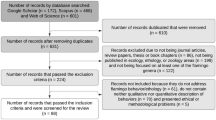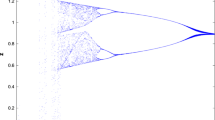Abstract
Under certain conditions a cannibalistic population can survive when food for the adults is too scarce to support a non-cannibalistic population. Cannibalism can have this lifeboat effect if (i) the juveniles feed on a resource inaccessible to the adults; and (ii) the adults are cannibalistic and thus incorporate indirectly the inaccessible resource. Using a simple model we conclude that the mechanism works when, at low population densities, the average yield, in terms of new offspring, due to the energy provided by one cannibalized juvenile is larger than one.
Similar content being viewed by others
References
Allee, W. C.: Cooperation among animals. New York: Henry Schuman 1938
Collette, B. B., Ali, M. A., Hokanson, K. E. F., Nagiec, M., Smirnov, S. A., Thorpe, J. E., Weatherley, A. H., Willemsen, J.: Biology of percids. J. Fish. Res. Board Can. 34, 1890–1899 (1977)
Cushing, J. M.: Equilibria in structured populations. J. Math. Biol. 23, 15–39 (1985)
De Roos, A. M.: Numerical methods for structured population models: the escalator boxcar train. Numerical methods for partial differential equations 4(3): 173–195 (1988)
Gabriel, W.: Can cannibalism be advantageous in cyclopoids? A mathematical model. Verh. Internat. Verein. Limnol. 22, 3164–3168 (1985a)
Gabriel, W.: Overcoming food limitations by cannibalism: A model study on cyclopoids. Arch. Hydrobiol. Beih. 21, 373–381 (1985b)
Gabriel, W.: Simulation komplexer Populationsdynamik. In: Möller, D. P. F. (ed.) Simulationstechnik (Informatik Fachberichte, vol. 109, pp. 318–324) 1985c
Gurney, W. S. C., Nisbet, R. M., Lawton, J. H.: The systematic formulation of tractable single-species population models incorporating age structure. J. Anim. Ecol. 52, 479–495 (1983).
Johnson, D., Walker, A. F.: The Zooplankton of Loch Leven. Kinross. Proc. R.S. Edinb. (B) 74, 285–294 (1972/73)
Maas, P., Gurney, W. S. C., Nisbet, R. M.: SOLVER — An adaptable program template for initial value problem solving. Applied Physics Industrial Consultants. Glasgow: Univ. of Strathclyde 1982; revised 1984
Murdoch, W. W., Oaten, A.: Predation and population stability. Advances in ecological research 9, 1–131 (1975)
Nikolskii, G. V.: Theory of fish population dynamics. Edinburgh: Oliver & Boyd 1969
Polis, G. A.: The evolution and dynamics of intraspecific predation. Ann. Rev. Ecol. Syst. 12, 225–251 (1981)
Popova, O. A., Sytina, L. A.: Food and feeding relations of eurasian perch (Perca fluviatilis) and pikeperch (Stizostedio luciperca) in various waters of the USSR. J. Fish. Res. Board Can. 34, 1559–1570 (1977)
Author information
Authors and Affiliations
Rights and permissions
About this article
Cite this article
van den Bosch, F., de Roos, A.M. & Gabriel, W. Cannibalism as a life boat mechanism. J. Math. Biology 26, 619–633 (1988). https://doi.org/10.1007/BF00276144
Revised:
Issue Date:
DOI: https://doi.org/10.1007/BF00276144




